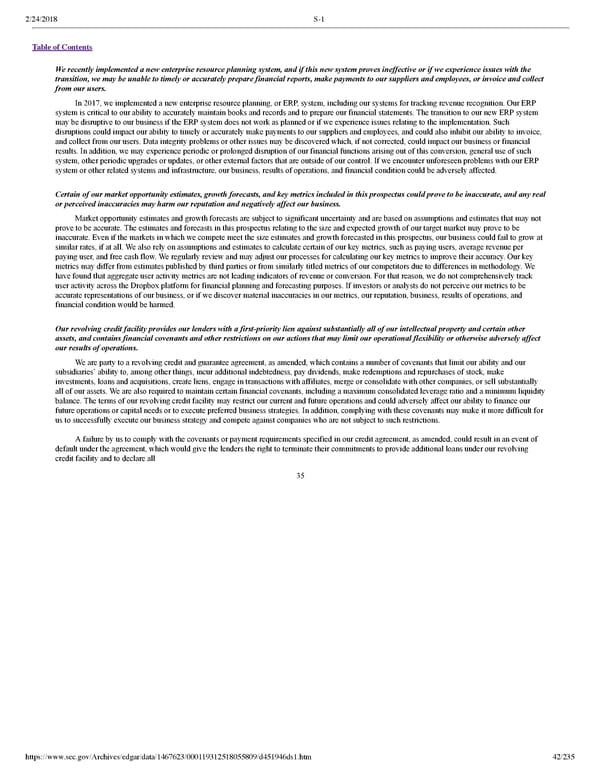2/24/2018 S-1 Table of Contents We recently implemented a new enterprise resource planning system, and if this new system proves ineffective or if we experience issues with the transition, we may be unable to timely or accurately prepare financial reports, make payments to our suppliers and employees, or invoice and collect from our users. In 2017, we implemented a new enterprise resource planning, or ERP, system, including our systems for tracking revenue recognition. Our ERP system is critical to our ability to accurately maintain books and records and to prepare our financial statements. The transition to our new ERP system may be disruptive to our business if the ERP system does not work as planned or if we experience issues relating to the implementation. Such disruptions could impact our ability to timely or accurately make payments to our suppliers and employees, and could also inhibit our ability to invoice, and collect from our users. Data integrity problems or other issues may be discovered which, if not corrected, could impact our business or financial results. In addition, we may experience periodic or prolonged disruption of our financial functions arising out of this conversion, general use of such system, other periodic upgrades or updates, or other external factors that are outside of our control. If we encounter unforeseen problems with our ERP system or other related systems and infrastructure, our business, results of operations, and financial condition could be adversely affected. Certain of our market opportunity estimates, growth forecasts, and key metrics included in this prospectus could prove to be inaccurate, and any real or perceived inaccuracies may harm our reputation and negatively affect our business. Market opportunity estimates and growth forecasts are subject to significant uncertainty and are based on assumptions and estimates that may not prove to be accurate. The estimates and forecasts in this prospectus relating to the size and expected growth of our target market may prove to be inaccurate. Even if the markets in which we compete meet the size estimates and growth forecasted in this prospectus, our business could fail to grow at similar rates, if at all. We also rely on assumptions and estimates to calculate certain of our key metrics, such as paying users, average revenue per paying user, and free cash flow. We regularly review and may adjust our processes for calculating our key metrics to improve their accuracy. Our key metrics may differ from estimates published by third parties or from similarly titled metrics of our competitors due to differences in methodology. We have found that aggregate user activity metrics are not leading indicators of revenue or conversion. For that reason, we do not comprehensively track user activity across the Dropbox platform for financial planning and forecasting purposes. If investors or analysts do not perceive our metrics to be accurate representations of our business, or if we discover material inaccuracies in our metrics, our reputation, business, results of operations, and financial condition would be harmed. Our revolving credit facility provides our lenders with a firstpriority lien against substantially all of our intellectual property and certain other assets, and contains financial covenants and other restrictions on our actions that may limit our operational flexibility or otherwise adversely affect our results of operations. We are party to a revolving credit and guarantee agreement, as amended, which contains a number of covenants that limit our ability and our subsidiaries’ ability to, among other things, incur additional indebtedness, pay dividends, make redemptions and repurchases of stock, make investments, loans and acquisitions, create liens, engage in transactions with affiliates, merge or consolidate with other companies, or sell substantially all of our assets. We are also required to maintain certain financial covenants, including a maximum consolidated leverage ratio and a minimum liquidity balance. The terms of our revolving credit facility may restrict our current and future operations and could adversely affect our ability to finance our future operations or capital needs or to execute preferred business strategies. In addition, complying with these covenants may make it more difficult for us to successfully execute our business strategy and compete against companies who are not subject to such restrictions. A failure by us to comply with the covenants or payment requirements specified in our credit agreement, as amended, could result in an event of default under the agreement, which would give the lenders the right to terminate their commitments to provide additional loans under our revolving credit facility and to declare all 35 https://www.sec.gov/Archives/edgar/data/1467623/000119312518055809/d451946ds1.htm 42/235
 Dropbox S-1 | Interactive Prospectus Page 41 Page 43
Dropbox S-1 | Interactive Prospectus Page 41 Page 43